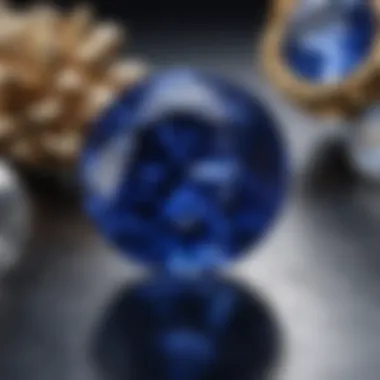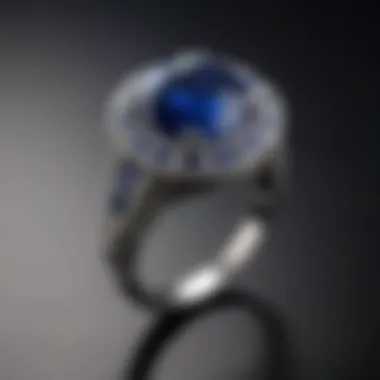Sapphires from Ceylon: A Detailed Insight


Intro
Sapphires from Ceylon, better known today as Sri Lanka, have enthralled gem enthusiasts and collectors for centuries. These exquisite gemstones are not just characterized by their beauty but also hold a wealth of history and significance, making them a topic worth exploring for anyone interested in gemstones. The journey of these sapphires from their geological origins to their current status in the global market illustrates an intricate tapestry of trade, culture, and craftsmanship.
This article sets out to illuminate the various facets of Ceylon sapphires, offering insights into their definition, historical relevance, unique properties, and the future outlook in the gemstone market. By understanding these aspects, collectors and enthusiasts can better appreciate the value and allure of these striking gemstones.
Gemstone Overview
Definition and Origins
Ceylon sapphires are a specific variety of corundum, a mineral that, besides sapphires, also gives birth to rubies. When we discuss sapphires, we usually think of their stunning blue hue, but they can actually appear in a range of colors—including pink, yellow, and green—due to various trace elements present during their formation. Sapphires are often found in alluvial deposits or within metamorphic rocks, developed over millions of years in the rich geological formations of Sri Lanka.
Sri Lanka's unique geology, with its limestone and basalt formations, creates an ideal environment for the formation of these gemstones. The country's land has been a significant source of sapphires since ancient times, reflecting an abundant legacy that garners the interest of gemstone aficionados worldwide.
Historical Significance
The history of Ceylon sapphires stretches back to ancient civilizations. Historical records indicate that these gemstones have been treasured for well over 2,000 years. In ancient Rome, sapphires were deemed symbols of wisdom. They were often associated with divine favor, and it was believed that they could protect their wearers from envy and harm.
Throughout the centuries, Ceylon sapphires made their way into royal collections and were visible in the ornate jewelry of kings and queens. It wasn’t just the aesthetic appeal that captured attention but also the gem's perceived metaphysical properties. During the Middle Ages, the belief in the power of sapphires to bring about peace and protection was widespread.
"The continued fascination with these gemstones reflects both their beauty and the profound stories they carry through time."
Today, Ceylon sapphires are celebrated not only for their exceptional beauty but for the intricate history that envelops each stone. The gemstone trade in Sri Lanka has evolved, attracting international buyers and sustaining local economies. Understanding this rich narrative is crucial for appreciating the full value of these timeless jewels.
Gemstone Properties
Hardness and Durability
Sapphires are renowned for their hardness, ranking a solid 9 on the Mohs scale, just below diamonds. This exceptional hardness makes them a popular choice for various types of jewelry, such as engagement rings and everyday wear. Their durability ensures that they can withstand the rigors of daily life, which is vital for many buyers focusing on longevity.
Color and Clarity
Typically, Ceylon sapphires are lauded for their vibrant colors, with the most sought-after hue being a velvety royal blue. However, they also come in a symphony of colors, shaped by the elements during their formation. Clarity plays a prominent role in a sapphire's value, and Ceylon sapphires are often noted for their exceptional transparency and brilliance.
Some key color characteristics include:
- A vivid primary color whether blue, yellow, or pink
- The presence of well-defined hues without noticeable color zoning
- Minimal inclusions that may hinder the overall appearance of the stone
The combination of these properties is essential in determining the desirability and market value of Ceylon sapphires. Collectors keen on investing will do well to pay attention to these factors, ensuring they acquire high-quality specimens.
By offering a detailed examination of Ceylon sapphires, this exploration hopes to equip gem enthusiasts with the knowledge needed to navigate the breathtaking yet complex world of these exquisite gemstones.
Intro to Ceylon Sapphires
Ceylon sapphires, regarded as some of the most sought-after gemstones in the world, hold a significant place in both the geologic and cultural fabric of Sri Lanka, formerly known as Ceylon. This section will illuminate why these sapphires are particularly unique and valued in various domains, from geology to jewelry design, and even among enthusiasts and collectors.
Understanding the historical context of Ceylon sapphires allows us to appreciate how these gemstones have influenced economies and cultures over centuries. The storied past of Ceylon sapphires is rich, with tales woven through ancient civilizations and royal treasures, showcasing their longstanding allure.
On the geological front, it’s crucial to recognize how Ceylon’s unique formation contributes to the sapphire’s color, clarity, and overall quality. The geological conditions in this region have birthed a variety of sapphires that are not just visually stunning but that also offer insight into the earth's natural processes.
Historical Context
Throughout millennia, the journey of Ceylon sapphires mirrors the broader history of Sri Lanka itself. These gemstones were first documented as early as 2000 BC, when they enchanted traders and royalty alike, often being associated with luxury and power. Ancient texts depict Ceylon as a land of gems, where sapphires have been revered not just for their beauty but also for the symbolism they held.
For instance, King Solomon is said to have owned sapphires from this very land, leading to their association with wisdom and divine favor. As trade routes evolved, particularly during the time of the Silk Road, sapphires from Ceylon garnered the attention of traders globally, linking the island to numerous cultures and traditions. The marriages of aristocrats often featured these exquisite stones, further solidifying their status. Today, Ceylon sapphires remain a symbol of prestige and status in jewelry.
Geological Significance
The geological formation of Ceylon presents a fascinating backdrop to the beauty of its sapphires. Nestled in the heart of an ancient land mass, Sri Lanka is rich in mineral diversity due to its complex geological history. The volcanic and metamorphic rocks provide the perfect environment for sapphire formation.
Sapphires form under specific conditions of temperature and pressure, and the particular combination found in Ceylon is exceptional. Their unique conditions yield a variety of colors, particularly the vivid blue that has made Ceylon sapphires a benchmark against which all other sapphires are measured.
Key Geological Elements of Ceylon Sapphires:
- Igneous and Metamorphic Rocks: The primary sources of sapphires in Sri Lanka.
- Deposits of Alluvial Soil: Many sapphires are found in riverbeds, making mining both an exciting and challenging affair.
- Variety of Colors: Influences from trace elements like iron and titanium give sapphires their iconic hues and saturation.
"Ceylon sapphires are not just beautiful—they are a tangible piece of Earth's history."
This narrative around Ceylon sapphires sheds light on their importance from historical and geological perspectives, setting the stage for a deeper understanding of their distinct characteristics. As we continue, we'll explore various types of Ceylon sapphires, their traits, cultural significance, and beyond.
Ceylon: The Sapphire Paradise
Ceylon, known for generations as a dazzling gem-producing locale, is a true haven for sapphire lovers. The island has built a reputation as a sapphire paradise, not merely for the volume of stones extracted, but for their unparalleled quality and diversity. This segment highlights the elements that contribute to Ceylon's esteemed status in the world of sapphires.
The geological tapestry of Ceylon creates the perfect conditions for sapphire formation. Rich in mineral deposits, the island's veins of corundum frequently yield strikingly vivid blue sapphires, along with an array of fancy colors, all thanks to unique local conditions. However, it isn’t merely about the gems—the art and tradition surrounding the mining and crafting of these stones play an equally vital role.
Not to mention, the climate of Ceylon helps create the excellent conditions necessary for gem mining. The tropical weather sees a combination of sun and rain that not only sustains life but impacts the geological shifts crucial for sapphire formation. Throughout the year, various regions experience monsoons, providing water that seeps into the earth, helping to wash sediment and facilitate mining operations. Thus, it is this unique interplay of geography and climate, beyond just the stones, that frames Ceylon as the sapphire paradise.
Geography and Climate
Ceylon's geography is characterized by rolling hills and lush plains, cutting across its landscape like nature’s brushstrokes. The diverse terrain—from the central mountainous region to the coastal areas—not only creates a visually stunning environment but also is a boon for sapphire mining. This intricate geography contributes to both the abundance and character of the sapphires extracted here.
The island experiences a tropical climate, typically warm and humid, which aids in the sustainable growth of flora and fauna. The seasonal monsoon rains bring necessary moisture, influencing the geological erosion that reveals new deposits directly to the surface. This cyclical growth continues to unveil rich sapphire deposits year after year. Mining operations tend to flourish in areas with the right combination of temperature and moisture levels, particularly during the rainy seasons when natural gem exposure is heightened.
"Ceylon’s rich, varied landscape doesn’t just create a beautiful backdrop—it plays a direct role in the formation and extraction of some of the finest sapphires in the world."
Mining Locations
Diving deeper into the mining locations, specific regions of Ceylon have gained notoriety for their sapphire deposits. Areas such as Ratnapura, known as the 'City of Gems', have been the epicenters of gemstone mining for generations. The ancient, artisanal mining techniques still used are a testament to their commitment to preserving traditional practices in the face of modernization.
Ratnapura’s mines are often steeped in local lore, with stories of mystical creatures guarding the stones, adding a layer of allure to the mining culture. Calibrating their practices with natural rhythms, local miners often employ environmentally friendly techniques—minimizing the impact on their surroundings while fetching some of the best sapphires available today.
Other notable regions include the areas surrounding the town of Elahera, where both alluvial and primary deposits are gathered. The miners strike from riverbanks and deeper underground, unearthing magnificent riches hidden beneath years of sediment.


As the demand for Ceylon sapphires continues to rise globally, understanding these specific locations and their significance in the trade becomes crucial. Mining spans generations, with families passing down methods and knowledge, ensuring these practices remain both prosperous and respectful to nature.
This careful balancing act between tradition and modern environmental considerations places Ceylon at the forefront of ethical gemstone sourcing, all while bolstering its reputation as the definitive sapphire paradise.
Types of Ceylon Sapphires
Understanding the types of Ceylon sapphires lays the foundation for appreciating their unique attributes and the role they play in the jewelry market. Each type possesses distinct qualities that not only influence their value but also their appeal among collectors and enthusiasts. Not all sapphires are created equal; this disparity is crucial when considering investment, craftsmanship, and aesthetic qualities.
Blue Sapphires
Blue sapphires are the most recognized among Ceylon's offerings, often referred to as the classic sapphire hue. Their deep, rich blue reflects both elegance and rarity, making them highly sought after. Geologically, the intense color comes from trace elements, particularly iron and titanium, during their formation. The sky-blue varieties, too—typically lighter and reminiscent of a clear summer sky—have their own charm and fan base.
- Color Clarity: The specific tone and saturation of blue sapphires can vary greatly. An exceptional Ceylon blue sapphire possesses a saturation that is both vibrant and consistent, which enhances its overall visual impact. Purchasing a blue sapphire often boils down to understanding the differences, as some might present a more violet or greenish tint.
- Market Demand: Ceylon blue sapphires tend to fetch a higher price tag compared to fancy colored ones, often due to historical significance and universal recognition. Collectors specifically look for stones with a vivid, purely blue tone, as they tend to command a premium in the marketplace.
"The value of a Ceylon blue sapphire lies not just in its hue but in its depth—a representation of timeless beauty that transcends generations."
Fancy Colors
Ceylon sapphires are not just about blue. The so-called fancy colors, including pink, yellow, orange, and green, exemplify nature's palette and are prized for their unique characteristics. These stones often have a lesser-known allure that captures the hearts of niche collectors.
- Unique Hues and Rarity: Particular fancy colors, like the vivid pink sapphires, are rare and can even outshine their blue counterparts in terms of vibrancy. The rarity of these stones often translates to higher prices, captivating those who seek exclusivity in their collection.
- Versatility in Design: Jewelers appreciate fancy-colored sapphires for their adaptability. They can be set in various styles and often complement different materials beautifully. For instance, a vivid yellow sapphire can create a striking contrast against white gold, making the piece pop!
- Cultural Significance: Different cultures attribute various meanings to these colors. For example, pink sapphires are seen as symbols of love and compassion in some traditions, adding a layer of emotional value for buyers.
In summary, the diversity of Ceylon sapphires, from the luxurious blue to the captivating fancy colors, illustrates the island's profound impact on the gemstone industry. Each type offers its own charm, beckoning gem enthusiasts and collectors to explore the dazzling world of Ceylon sapphires.
Distinct Characteristics
When it comes to Ceylon sapphires, their distinct characteristics play a significant role in defining both their aesthetic value and market worth. These unique traits not only mesmerize gemstone collectors but also lay the groundwork for discerning quality and authenticity. Understanding the nature of these stones leads to an appreciation of their artistry and the science behind their formation.
Color Quality and Influence
Color is undoubtedly the crown jewel of sapphire characteristics. Ceylon sapphires are celebrated for their vivid hues, particularly in azure tones that rival the sky. The depth and intensity of the color can greatly influence its value. A rich, royal blue often fetches a premium in the market, while lighter shades might carry a more moderate price tag. However, what sets Ceylon sapphires apart is their remarkable consistency in color quality.
When it comes to color influence, Ceylon sapphires offer a spectrum that extends beyond blue. From vibrant yellows to luscious pinks, each hue carries different connotations and market demand. The presence of trace elements, such as iron and titanium, contributes to the diverse palette, each providing a unique characteristic to the stone.
Consider these key factors when evaluating color quality in Ceylon sapphires:
- Hue: The primary color of the sapphire can range from deep blue to lighter shades, or even fancy colors like pink and yellow.
- Tone: This refers to the lightness or darkness of the sapphire's color. A bright blue stone is often more desirable than a duller one.
- Saturation: A gemstone's color richness also drastically affects its appeal. A vivid saturation level typically results in higher market value.
"The allure of color in Ceylon sapphires cannot be overstated; it is the heart and soul of what makes these gems so enchanting, and their variation tells a story of nature's artistry."
Clarity and Cut
Following closely on the heels of color, clarity and cut are paramount in defining the overall elegance of Ceylon sapphires. Clarity refers to the absence of inclusions or blemishes within the stone. Generally, the clearer the sapphire, the higher its value. That said, inclusions can sometimes create unique optical effects and patterns, which certain buyers may find attractive.
Ceylon sapphires are often produced with a focus on achieving high clarity, as gemologists know that buyers are generally attracted to pristine examples. However, when certain beryllium treatments are employed, it can enhance the clarity levels of the gemstone, which is a point of consideration for authenticity.
As for the cut, this refers to how a gemstone is shaped and faceted. The quality of the cut influences not just the stone's brilliance and sparkle but also how light interacts with its surfaces. An expertly cut sapphire will capture light beautifully and display superior luster. Factors to contemplate include:
- Cut Style: Common styles for Ceylon sapphires include oval, round, and cushion cuts, with each style affecting overall aesthetics.
- Proportions: Well-proportioned cuts ensure that a sapphire throws off maximum light, enhancing its visual appeal.
- Polish and Finish: A high-quality finish results in a sharp, bright appearance that elevates the stone's overall perceived value.
Understanding these distinct characteristics not only aids enthusiasts in appreciating Ceylon sapphires but also serves as a vital compass when navigating purchasing decisions.
Cultural Importance of Ceylon Sapphires
Ceylon sapphires are not just gemstones; they are deeply woven into the cultural tapestry of societies that value their luster and beauty. Their significance goes beyond aesthetics, touching on themes of identity, legacy, and even spirituality. Throughout history, various societies have attributed distinct meanings to these gemstones, showcasing their multifaceted role in different cultures.
The allure of Ceylon sapphires stems from their breathtaking colors and exceptional clarity, but their cultural importance adds a layer of depth that enriches the narrative of these gems. Many view sapphires as tokens of fortune and prosperity, while others consider them symbols of wisdom and nobility. In royal circles, they have long been associated with divine favor, often adorning crowns, scepters, and other regal attire, elevating their status within the gemstone hierarchy.
Symbolism in Different Societies
The symbolic meanings of Ceylon sapphires shift with the cultural contexts in which they are revered. In Sri Lanka itself, the gem is considered a national treasure. Here, sapphires are often linked with Buddhist beliefs, embodying purity and wisdom. Many Sri Lankans believe wearing a sapphire can bring peace and harmony to one's life, fostering a sense of tranquility amid chaos.
In Western cultures, sapphires have found their way into engagement rings, symbolizing fidelity and commitment. The famous phrase "something blue" during weddings often features sapphires, embodying the wish for happiness and peace in the marriage. Across different regions, sapphires also signify truth and sincerity, qualities that are universally appreciated.
- In Thailand, they symbolize love and loyalty, frequently included in ceremonial ornaments.
- In ancient Rome, they were believed to protect against envy and harm.
- In various African cultures, sapphires represent wealth and prestige, often used to adorn ceremonial attire.
The Ceylon sapphire's symbolism is a testament to its versatility, serving as a bridge between various cultural beliefs.
Legends and Myths
Legends surrounding Ceylon sapphires further illuminate their importance through imaginative storytelling. One prevalent myth is the belief that sapphires are the tears of the heavens. This poetic imagery captures the essence of how these gemstones are perceived as gifts from the gods, imbued with the elements of nature.
In Sri Lanka, there's a fascinating legend that connects sapphires to the divine. According to folklore, when the earth was created, the sapphire was one of the first gems formed. This tale emphasizes the idea that sapphires were meant to adorn humanity from time immemorial, an embodiment of beauty and rarity.
Other cultures have their own versions of sapphire myths:
- In ancient Persia, sapphires were believed to reflect the heavens, influencing the power of the stars on Earth.
- In Hindu myths, they are associated with the deity Vishnu and are said to attract good fortune and success.
Such legends collectively underscore the cherished stature of Ceylon sapphires, confirming their role as more than just a luxury item; they are steeped in history and lore that resonates with people across various backgrounds.
Trade Dynamics and Market Trends
Understanding the trade dynamics and market trends surrounding Ceylon sapphires is of utmost importance for several reasons. This information not only helps enthusiasts, collectors, and investors comprehend the performance of these diverse gemstones in a fluctuating market but also sheds light on the cultural and economic factors shaping the industry. With sapphire markets closely tied to global jewelry demand and aesthetic preferences, staying informed on current trends is key for making informed decisions on purchases and investments.
Export Statistics
Export statistics serve as a litmus test for the health of the Ceylon sapphire industry. In recent years, data shows fluctuations in the volumes exported from Sri Lanka, predominantly driven by changing consumer preferences and economic conditions around the globe.
- 2019-2020: Exports reached a peak, attributed to a resurgence in luxury spending.
- 2021: There was a noticeable drop as economies faced challenges from the pandemic. Demand worldwide slumped temporarily, causing prices to dip.
- 2022-Present: A gradual recovery is underway, with export numbers showing signs of stability and growth once again, particularly in the United States and Europe.
The sustained interest in ethically sourced gemstones also plays a pivotal role. As buyers become more conscientious about their purchases, Ceylon sapphires—widely regarded for their quality and sourcing practices—are likely to remain in high demand.
Global Competitors
While Ceylon sapphires hold a revered position in the gemstone world, they face competition from other regions known for their sapphire production.


- Burma (Myanmar): Burmese sapphires are famed for their vibrant, rich blue shades. They command high premium but also face scrutiny over ethical mining practices.
- Madagascar: Emerging as a strong player, Madagascar sapphires showcase a range of colors, often appealing to collectors interested in fancy hues. With relatively lesser price points, they present an attractive alternative.
- Thailand: While primarily known for cutting and trading rather than mining, Thailand's craftsmanship is superb, making it a strong competitor in the final product market.
These competitors create a landscape where Ceylon sapphires need to maintain their unique value proposition—focusing on quality, ethical sourcing, and innovative designs in jewelry settings to compete effectively. As trends shift, staying ahead with adaptive strategies becomes increasingly vital for the success of Ceylon sapphires in this global marketplace.
"In the world of gemology, the might of Ceylon sapphires lies in their history, quality, and the ethical stance of their trade. Staying ahead of global shifts is critical for maintaining this legacy."
Ceylon Sapphire Care Guidelines
Ceylon sapphires, renowned for their breathtaking beauty and unique characteristics, require special attention to maintain their luster and integrity. Caring for these gemstones is not merely a question of aesthetic preservation but also about ensuring their longevity. Given their market value and sentimental worth, proper cleaning and maintenance methods shine as essential practices for enthusiasts and collectors alike.
Cleaning and Maintenance
Ceylon sapphires, while durable, still require careful cleaning to prevent buildup of dust, oils, and other residues. A gentle approach is key. Here are some effective tips for maintaining their brilliance:
- Use mild soap: A few drops of mild dish soap mixed with lukewarm water can create a gentle cleaning solution. Avoid harsh chemicals that could damage the stone’s surface.
- Soft brush application: Utilize a soft bristle brush, such as a tooth brush, to clean the surface. Gently scrub the stone to remove trapped dirt without scratching it.
- Rinse thoroughly: After cleaning, rinse the sapphire under running water to wash away soap residue. Ensure the sink is plugged or use a bowl to avoid accidental slips into the drain.
- Dry with care: Use a lint-free cloth to dry the sapphire. Avoid tissues or paper towels as they may leave fibers or scratches on the surface.
By following these steps, the vibrant colors and clarity of your Ceylon sapphires can be preserved. Regular cleaning not only enhances their appearance but also allows for early detection of any issues, such as scratches or loose settings.
Storage Best Practices
Correct storage is crucial to protecting Ceylon sapphires from damage. Jewelry can easily be damaged through careless storage practices. Here are several effective strategies:
- Separate compartments: Store sapphires in a separate compartment of a jewelry box, preventing any friction with other stones or metals that could scratch them.
- Soft lining: Ensure that the storage area has a soft lining, such as velvet or silk, to cushion against shocks and prevent scratches.
- Avoid extreme conditions: Keep sapphires away from direct sunlight and extreme temperature fluctuations, which can affect their color and internal structure over time.
- Regular check-ups: Periodically inspect your gemstones and their settings to spot any potential vulnerabilities or issues that might have developed while in storage.
By adhering to these storage best practices, collectors can not only maintain their sapphires in pristine conditions but also enhance their overall investment value. Taking the time to ensure proper care extends the life of these stunning stones, keeping them brilliant for years to come.
"A little care goes a long way for keeping sapphires dazzling," says many gem enthusiasts, emphasizing the importance of maintenance practices.
Identification of Authentic Ceylon Sapphires
The quest for authentic Ceylon sapphires holds paramount significance for both gemstone collectors and enthusiasts. With the market inundated with imitations and substitutes, discerning the genuine article can feel like chasing shadows. Understanding how to identify these sapphires not only enhances one’s collection but also ensures that investment decisions are sound and rewarding. Authenticity in this context imbues the gem with an essence and value that mere imitations can never achieve.
Examining Gemological Traits
To recognize an authentic Ceylon sapphire, one must delve into its gemological traits. A range of parameters come into play, typically encompassing color, clarity, cut, and carat weight.
- Color: Ceylon sapphires are renowned for their exquisite blue hues, often described as cornflower blue or royal blue. However, they are not limited to blue alone; a spectrum of colors exists, including pink, yellow, and green. What sets Ceylon apart is the vividness and saturation of these colors. Examining the saturation level can be quite revealing.
- Clarity: The presence of inclusions or imperfections can also signify authenticity. Natural sapphires frequently display minor inclusions, known as fingerprints, which is a hallmark of genuine stones. These can be better analyzed using a simple jeweler's loupe or microscope.
- Cut: The craftsmanship of the cut influences the overall aesthetic appeal and brilliance of the gemstone. Authentic Ceylon sapphires are often cut in a way that maximizes their color and does so without compromising the stone's integrity.
By focusing on these gemological traits, enthusiasts can tangibly assess the authenticity of Ceylon sapphires, steering clear of inferior substitutes.
Use of Certification
The importance of certification cannot be understated in the realm of genuine Ceylon sapphires. This aspect serves as both a safeguard and a marker of trustworthiness, especially in a market often clouded by deceitful practices. Professional gemological laboratories, such as the Gemological Institute of America (GIA) or the International Gemological Institute (IGI), provide reliable certification that validates a sapphire's origin and quality. A certification report typically covers the following aspects:
- Origin: It verifies the geographic origin, confirming if the sapphire is indeed from Ceylon.
- Quality Assessment: This includes a detailed evaluation of the sapphire's color, clarity, cut, and carat weight.
- Treatment Disclosure: The report indicates whether the sapphire has undergone any treatments, like heating, that could alter its natural state.
About 90% of sapphires on the market are heat-treated, making such disclosures vital for informed purchasing decisions.
Challenges Facing the Ceylon Sapphire Industry
The Ceylon sapphire industry stands at a crossroads, facing a myriad of challenges that threaten its sustainability and reputation. Understanding these hurdles is critical, as they influence not only the gemstones' market value but also the communities reliant on this trade. The intrinsic beauty and allure of Ceylon sapphires are undeniable, but without addressing these challenges, their future can be in jeopardy.
Environmental Impact
One of the foremost concerns surrounding the Ceylon sapphire mining industry is its environmental repercussions. Mining activities can lead to significant degradation of the local ecosystem. Deforestation, soil erosion, and water contamination are rampant in areas where mining is prevalent. The delicate balance between preserving the rich biodiversity of the region and extracting valuable gems poses a complex challenge.
- Water Contamination: Mining operations often use chemicals that can seep into local water supplies, posing a threat to both human health and aquatic life. Communities that depend on these water sources for drinking and agriculture may find their livelihoods endangered.
- Habitat Destruction: Endemic species, some unique to Sri Lanka, face extinction due to habitat loss. As mining encroaches on these habitats, the rich flora and fauna that define the island's natural beauty are put at risk.
- Waste Management: The rejection of tailings, or leftover material, can lead to further landscape alteration and pollution. Proper waste management practices need to be enforced to minimize these negative impacts and ensure a balanced approach to gem extraction.
The repercussions of these activities not only affect environmental sustainability but also tarnish the reputation of Ceylon sapphires in the global market, making consumers increasingly conscious of ethical sourcing.
Regulatory Issues
Regulation surrounding the sapphire industry poses its challenges, bringing forth a range of issues from legality to enforcement. Governments face the difficult task of creating policies that protect both the gem industry and the environment. However, gaps exist in the current regulatory framework.
- Lack of Enforcement: Even where regulations do exist, enforcement is often weak. This leads to illegal mining operations that exacerbate environmental impacts and undermine legitimate businesses. Ensuring compliance with mining permits and environmental guidelines is vital for sustainable practices.
- Corruption and Transparency: Corruption can hinder effective regulation, allowing illegal mining practices to flourish. This compromises the integrity of the industry and contributes to social unrest. Transparency in licenses and permits is crucial to preventing unethical exploitation.
- Policy Development: The lack of cohesive policies that integrate environmental sustainability and economic growth creates gaps. A multi-stakeholder approach involving miners, local communities, government, and environmental organizations is essential to create effective regulations.
Investing in robust regulatory frameworks can pave the way towards a more sustainable sapphire industry, aligning economic interests with environmental and social responsibility.
As the Ceylon sapphire industry navigates these challenges, the commitment to environmental preservation and ethical practices will determine its longevity and success in the competitive global market.
Future of Ceylon Sapphires
The future of sapphires from Ceylon, known for their breathtaking beauty and unique characteristics, holds both promise and challenges. As the global demand continues to evolve, understanding the shifts in consumer preferences and the broader market dynamics will be crucial for stakeholders—from miners to jewelers.
The importance of this topic lies in its multifaceted implications for the gemstone industry. Ceylon sapphires are not just objects of desire; they embody cultural history, environmental significance, and economic value. As we move forward, assessing specific factors such as sustainable sourcing, ethical practices, and market trends will shape the narrative surrounding these gemstones.
Emerging Trends
As the world becomes ever more interconnected, several emerging trends are impacting the market for Ceylon sapphires. Below are key aspects to consider:
- Consumer Preferences: With a growing awareness of ethical sourcing, buyers increasingly seek gemstones that are traceable and sustainably mined. This shift pushes companies to adopt transparency in their supply chains.
- Technological Advances: Innovations in gemology and digital marketing are transforming how sapphires are sold. Online platforms allow consumers to explore sapphires virtually, enhancing the buying experience.
- Customization: There's a rise in demand for personalized jewelry. Buyers are now more inclined to seek out unique designs, leading to a greater focus on custom settings for these gemstones.
- Investment Potential: Sapphire prices have shown resilience in fluctuating economies, making them an attractive option for investors. Savvy collectors are recognizing the long-term value that quality Ceylon sapphires can offer.
These trends signal a vibrant future for Ceylon sapphires, where adaptability will be vital for remaining competitive in the global market.
Sustainable Practices
In recent years, sustainability has climbed to the forefront of industry discussions. The shift towards sustainable practices is not merely a trend; it’s a necessity in preserving both the environment and the heritage of Ceylon sapphires. Here are essential elements to consider:
- Responsible Mining: Companies are working to implement environmentally friendly mining techniques. This includes reducing land degradation and using water resources wisely, which is crucial for surrounding ecosystems.
- Community Engagement: By engaging local communities, businesses can create a symbiotic relationship. This not only fosters local economies but also ensures that the benefits of sapphire mining are shared, making it a win-win scenario.
- Certification Programs: The implementation of certification programs plays a pivotal role in assuring consumers of the authenticity and ethical provenance of the gems. Buyers are more inclined to invest when they know their sapphires are sourced responsibly.
- Circular Economy Initiatives: The push towards a circular economy encourages practices like recycling and reusing gemstones. Jewelers are beginning to offer services to transform older jewelry into new, modern pieces, making the most out of existing resources.
"Innovating responsibly is the key to ensuring that the beauty of Ceylon sapphires endures for generations to come."
Comparative Analysis with Other Sapphires


The gem world is as vast as the ocean, and among its treasures, sapphires from Ceylon hold a distinguished place. Analyzing Ceylon sapphires in relation to their counterparts provides valuable insights into their distinct characteristics, appeal, and market dynamics. This comparative study not only amplifies appreciation for Ceylon sapphires but also educates collectors and enthusiasts about the variances that influence their value and desirability in the gemological realm.
Differences from Burmese Sapphires
Burmese sapphires, commonly hailing from Myanmar, are renowned for their rich colors and exceptional clarity. When one compares these to Ceylon sapphires, it’s crucial to acknowledge the geographical and geological variations that set them apart.
- Color Variations: Burmese sapphires often display deeper, more saturated hues than many Ceylon variants. In contrast, Ceylon sapphires are celebrated for their vibrant blue shades marked by a slightly lighter tone. This delicate difference can often be seen as the result of distinct mineral compositions.
- Clarity and Transparency: Burmese sapphires frequently exhibit fewer inclusions, which can make them appear more desirable to some buyers. While Ceylon sapphires do possess clarity, they also come with unique inclusions that can tell a story about their geological journey.
- Market Perception: In the jewelry world, Burmese sapphires may carry a premium due to their scarcity and historical significance. On the other hand, Ceylon sapphires are valued for their diverse color palette and ethical sourcing, as Sri Lanka emphasizes sustainable practices in mining.
Ceylon sapphires can often be found at more accessible price points compared to those from Burma, making them an attractive option for both new collectors and seasoned buyers.
Contrasting Madagascan Varieties
Madagascar has emerged as a significant player in the sapphire market in recent years, producing gems that are often compared to Ceylon's offerings. Here, the differences can be quite striking:
- Color Spectrum: Madagascan sapphires are unique in that they can exhibit a range of colors, including vibrant pinks and yellows beyond the classic blue. While Ceylon sapphires tend to lean more towards traditional blue tones—though, they too can boast a variety of colors like orange and green—Madagascan varieties can surprise with their vividness.
- Treatment Practices: The treatment of stones is another central theme. While many sapphires worldwide undergo heat treatment to enhance color, analyses show that a remarkable number of Madagascan stones are sold untreated. This can make them appealing to purists who favor natural beauty.
- Ethical Considerations: Ethical sourcing is becoming a significant factor in the market, and Madagascar has faced scrutiny regarding labor practices in its mining operations. Meanwhile, Sri Lanka has made strides in ensuring ethical practices, positively impacting the perception and value of Ceylon sapphires.
"When purchasing a sapphire, one must consider the source and the story behind each gem, as the narrative can add immeasurable value to one’s collection."
Ceylon Sapphire Jewelry
Ceylon sapphire jewelry carries not just intrinsic value, but also a story that spans thousands of years. The allure of these gems transcends mere aesthetics; they embody the earth's unique beauty and the creativity of artisans who transform raw stones into breathtaking pieces of adornment. For gemstone enthusiasts, collectors, and jewelry designers, understanding this jewelry is essential for appreciating the nuances and potentials they offer.
The significance of Ceylon sapphires in jewelry design lies in their hues and clarity. Many jewelers choose these sapphires not just for their striking appearance, but also for their historical roots. These stones have adorned crowns and worn by royals, connecting modern wearers with a legacy of nobility. The feted blue, but also the enticing array of fancy colors, allow for diverse design options, giving designers plenty of room to create unique pieces that are personalized as well as luxurious.
Design Inspirations
When it comes to design inspirations, Ceylon sapphires offer nearly endless possibilities. Their vibrant colors spark creativity in various design realms. Several design trends encapsulate the spirit of these exquisite gems:
- Vintage Styles: Drawing from the deep historical significance of sapphires, many designers lean on vintage elements, reminiscent of earlier eras when these gems first flourished.
- Nature-Inspired: Designers often look to nature's forms, finding inspiration in flora and fauna around them. Organic shapes and asymmetrical designs can beautifully complement the structure of Ceylon sapphires.
- Art Deco: This style's geometric forms mesh well with the precision needed for cutting sapphires, allowing for a stunning balance between the sharpness of the cut and the smoothness that Ceylon sapphires possess.
- Cultural Motifs: Reflecting Sri Lanka's rich culture, some jewelers incorporate traditional symbols to connect the wearer with the gem's heritage.
Ceylon sapphires inspire designers to blend tradition with innovation, making every piece truly unique.
Popular Settings
The setting of a Ceylon sapphire is crucial, as it can enhance the stone's allure and protect its integrity. Some popular settings that showcase these gems beautifully include:
- Solitaire: A timeless choice where one stunning sapphire stands alone, allowing its beauty to shine without distractions.
- Halo: Surrounding a central Ceylon sapphire with smaller diamonds or colored gemstones creates a radiant effect, drawing the eye towards the main stone.
- Three-Stone: This setting features two side stones, which could be sapphires or contrasting gems, symbolizing the past, present, and future—often a popular design for engagements.
- Pave: Tiny stones are set closely together to create the illusion of a larger gemstone, complementing Ceylon sapphires with additional sparkly accents.
The way Ceylon sapphires are set can tell a story all on their own. With an understanding of the jewelry and its relation to culture, history, and design, enthusiasts and collectors can appreciate these gems on a deeper level. Understanding the delicate blend of creativity and craftsmanship highlights the significant role Ceylon sapphires play in not just jewelry but also the broader historical and cultural narratives of beauty.
Market Value Assessment
In the world of gemstones, understanding the market value of Ceylon sapphires is crucial for both buyers and sellers. This section serves to illuminate the various elements that contribute to the valuation of these exquisite stones, discussing their significance not just as decorative items, but as investments with tangible and emotional worth. Ceylon sapphires possess distinct attributes that set them apart, creating a lively marketplace filled with unique opportunities and challenges.
Factors Influencing Price
Several factors play a pivotal role in determining the price of Ceylon sapphires. These are some of the key aspects that industry players should keep in mind:
- Color Quality: The depth and hue of a sapphire’s color is arguably the most important factor. Ceylon sapphires are renowned for their vibrant blue shades, often described as royal blue. The most sought-after stones display a deep color with minimal zoning.
- Clarity: Transparency and the absence of inclusions significantly impact value. A flawless Ceylon sapphire can fetch much higher prices than one with visible inclusions, even if the latter has a stunning color.
- Cut: The craftsmanship involved in cutting a sapphire affects its brilliance. Well-cut stones maximize light reflection, making them more appealing and valuable.
- Origin: Certainty of origin can greatly enhance a sapphire's worth. Desirable gemstones from Sri Lanka, known for their quality, are often more desired than those from lesser-known sources.
- Market Trends: Like any commodity, fluctuations in demand and supply chain disruptions can influence pricing. A growing trend towards ethical and sustainably sourced stones is also shaping buyer preferences today.
"The beauty of a sapphire resides not just in its color, but in the art of its presentation, the assurance of its origin, and the care with which it has been mined."
Investment Potential
Investing in Ceylon sapphires offers a fascinating avenue for those looking to diversify their portfolios. These gemstones are not just luxuries; they hold potential for appreciation over time. Here are several points to consider regarding their investment potential:
- Historical Appreciation: The value of high-quality sapphires has generally followed an upward trend. Buying when prices are right can lead to substantial returns, particularly with the growing cultural fascination with colored gemstones among collectors across the globe.
- Limited Supply: With mining operations becoming increasingly stringent due to environmental regulations and resource depletion, the supply of high-quality Ceylon sapphires may dwindle, potentially escalating their value in the future.
- Aesthetic Timelessness: Unlike other investments that might trend with the market, the inherent beauty of sapphires transcends time. This intrinsic value can make them appealing, as buyers seek both luxury and lasting beauty.
- Tangible Asset: In uncertain economic times, physical assets like gemstones often remain stable, providing a sense of security to investors wary of volatility in stock markets or currency fluctuations.
In summary, assessing the market value of Ceylon sapphires not only allows potential buyers to make informed decisions but also opens the door to investment opportunities that may yield fruitful returns. Understanding the factors that influence prices and the potential for appreciation provides rich ground for both collectors and investors alike.
Closure
In concluding our exploration of Ceylon sapphires, it's vital to acknowledge the multifaceted nature of these exquisite gemstones. Not only do they boast a rich history intertwined with the cultural fabric of Sri Lanka, but they also present unique geological characteristics that set them apart from their counterparts around the globe.
The invaluable insights provided within this article highlight key aspects that every gemstone enthusiast, collector, and jewelry designer should consider when engaging with Ceylon sapphires. Importantly, the historical context offers a glimpse into how these gems were revered in ancient civilizations, enhancing their allure in today's market.
Moreover, understanding the distinct characteristics of color, clarity, and cut plays a significant role in appreciating the true value of these stones. Ceylon sapphires, especially the blue varieties, have become emblematic indicators of prestige and elegance, making them a sought-after choice for jewelry designers looking to elevate their craft.
"Ceylon sapphires are not just gemstones; they embody centuries of history, culture, and artistry."
As we move into an era where sustainability and ethical sourcing are becoming non-negotiable in the jewelry industry, the future of Ceylon sapphires is indeed promising. With increasing awareness and demand for responsibly sourced gems, we expect these sapphires to maintain their status while adapting to modern standards.
In summation, immersing oneself in the world of Ceylon sapphires reveals not only their beauty but also the stories they tell. Every piece crafted from these stones is a testament to nature's artistry and human creativity, ensuring their continued relevance for generations to come.
References and Further Reading
When it comes to deepening one's understanding of Ceylon sapphires, engaging with the right references and further reading materials is essential. These sources provide a well-rounded view of the gemstone's rich heritage, geology, and cultural significance, enhancing the overall appreciation for this lustrous specimen.
Importance of References
References serve multiple purposes in understanding the complexities surrounding Ceylon sapphires:
- Historical Insight: Many books and articles discuss the historical contexts in which these sapphires were cherished, tracing their journey through trade routes and royal ceremonies. By studying these writings, one can start to appreciate why Ceylon sapphires hold an esteemed place in both history and modern society.
- Geological Understanding: Readers can explore comprehensive geology texts that delve into the formation processes and locations where Ceylon sapphires are mined. Understanding the natural processes behind these gemstones adds depth to their allure.
- Cultural Perspectives: Articles and documentaries often highlight how different societies view sapphires, from symbols of wealth to talismans believed to bring safety. These sources enrich knowledge about the varied cultural narratives that surround sapphires.
Suggested Readings and Resources
Here are some recommended sources to foster a richer understanding of Ceylon sapphires:
- Books:
- Web Resources:
- Online Communities:
- Gemstones of the World by Walter Schumann – A classic reference for all gemstone lovers.
- Secrets of the Gem Trade by Richard M. Rosenberg – An insightful exploration of the trade dynamics affecting gemstones, including sapphires.
- Wikipedia on Sapphires – Provides fundamental details and context about sapphires globally, including Ceylon varieties.
- Britannica on Gemstones – A deeper dive into the significance and types of gemstones.
- Reddit - Gemstone Enthusiasts – A place for discussions, knowledge sharing, and queries regarding sapphires and other gemstones.
- Facebook Groups related to gemstones and Ceylon sapphires for real-time conversations and experiences.
Ending
Engaging with these references not only fills gaps in knowledge but also fuels enthusiasm for collecting and admiring Ceylon sapphires. Each source contributes a unique perspective, whether historical, geological, or cultural, allowing readers to forge a more profound connection with these magnificent gems.
"Knowledge is the finest gem of all."
This quote succinctly captures the idea that a more profound understanding of sapphires elevates their appreciation, transforming mere interest into passion.



